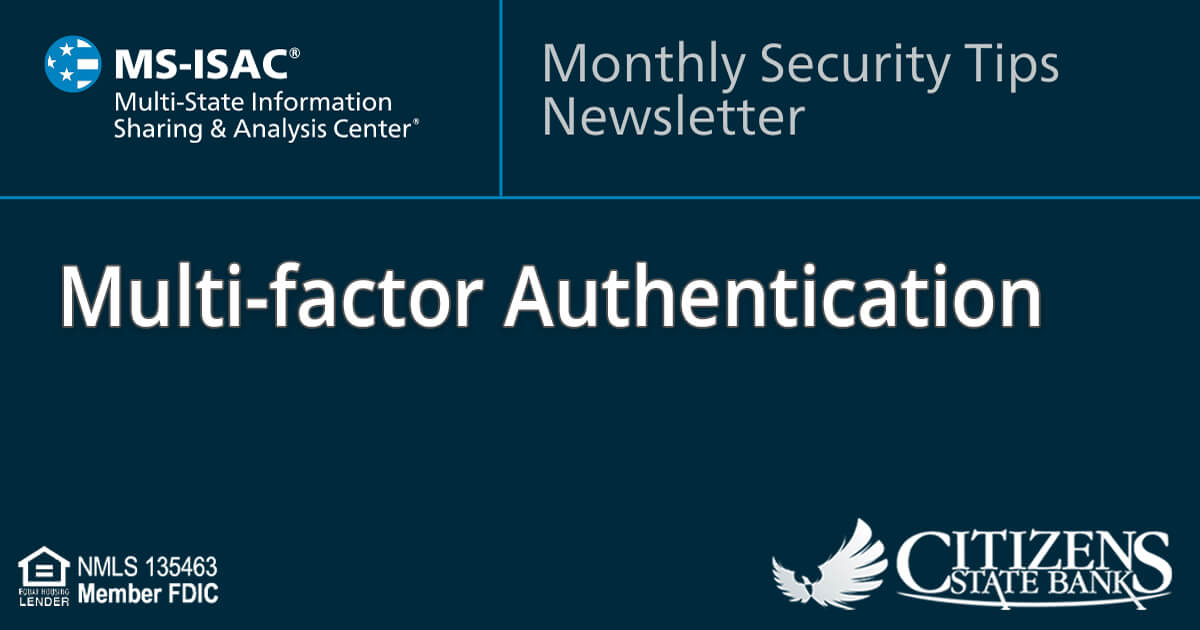 Have you noticed how often security breaches, stolen data, and identity theft are front-page news? Perhaps you, or someone you know, are victims of cyber criminals who stole personal information, banking credentials, or more. As these incidents become more prevalent, you should consider using multi-factor authentication (MFA), which is often called strong or two-factor authentication, to secure your information. This technology is likely familiar to you, as many financial institutions require both a password and one of the following to log in: a call, email, or text containing a code.
Have you noticed how often security breaches, stolen data, and identity theft are front-page news? Perhaps you, or someone you know, are victims of cyber criminals who stole personal information, banking credentials, or more. As these incidents become more prevalent, you should consider using multi-factor authentication (MFA), which is often called strong or two-factor authentication, to secure your information. This technology is likely familiar to you, as many financial institutions require both a password and one of the following to log in: a call, email, or text containing a code.
What It Is
MFA is defined as a security process that requires more than one method of authentication from independent sources to verify the user’s identity. In other words, a person wishing to use the system is given access only after providing two or more pieces of information which uniquely identifies them. (Think of it as providing two forms of ID in order to get a new license.)
How It Works
There are three categories of credentials: something you either know, have, or are. Here are some examples in each category.
Something You Know
Password/Passphrase
PIN Number
Something You Have
Security Token or App
Verification Text, Call, Email
Smart Card
Something You Are
Fingerprint
Facial Recognition
Voice Recognition
In order to gain access, your credentials must come from at least two different categories. One of the most common methods is to login using your user name and password. Then a unique one-time code will be generated and sent to your phone or email, which you would subsequently enter within the allotted amount of time. This unique code is the second factor.
When should it be used?
MFA should be used to add an additional layer of security around sites containing sensitive information, or whenever enhanced security is desirable. MFA makes it more difficult for unauthorized people to log in as the account holder. According to the National Institute of Standards and Technology (NIST) MFA should be used whenever possible, especially when it comes to your most sensitive data – like your primary email, financial accounts, and health records. Some organizations will require you to use MFA; with others it is optional. If you have the option to enable it you should take the initiative to do so to protect your data and your identity.
Activate MFA on your accounts right away!
To learn how to activate MFA on your accounts, head to Lock Down Your Login, which provides instructions on how to apply this security to many common websites and software products you may use. Lock Down Your Login is a resource created by the National Cyber Security Alliance and the U.S. Department of Homeland Security through their Stop Think Connect campaign to empower citizens with cybersecurity knowledge and practices.
If any of your accounts are not listed on that resource site, look at your account settings or user profile and check whether MFA is an available option. If you see it there, consider implementing it right away!
Conclusion
User name and password are no longer sufficient to protect accounts with sensitive information. By using multifactor authentication you can protect these accounts and reduce the risk of online fraud and identify theft. Consider also activating this feature on your social media accounts!
Resources:
https://www.us-cert.gov/ncas/tips/ST05-012
The information provided in the MS-ISAC Monthly Security Tips Newsletter is intended to increase the security awareness of an organization's end users and to help them behave in a more secure manner within their work environment. While some of the tips may relate to maintaining a home computer, the increased awareness is intended to help improve the organization's overall cyber security posture. This is especially critical if employees access their work network from their home computer. Organizations have permission and are encouraged to brand and redistribute this newsletter in whole for educational, non-commercial purposes.
Disclaimer: These links are provided because they have information that may be useful. The Center for Internet Security (CIS) does not warrant the accuracy of any information contained in the links and neither endorses nor intends to promote the advertising of the resources listed herein. The opinions and statements contained in such resources are those of the author(s) and do not necessarily represent the opinions of CIS.
The views, information, or opinions expressed in this article are solely those of the author and do not necessarily represent the views of Citizens State Bank and its affiliates, and Citizens State Bank is not responsible for and does not verify the accuracy of any information contained in this article or items hyperlinked within. This is for informational purposes and is no way intended to provide legal advice.